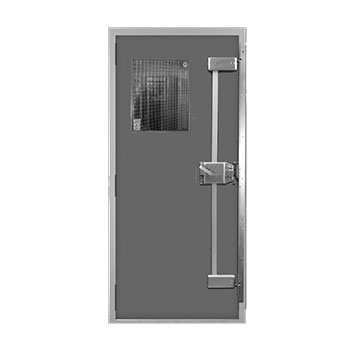The “Time-out Room,” also called a “Seclusion Room,” is, perhaps, a sign of our times. The purpose of a time-out room in a middle school or elementary school is to temporarily segregate an out-of-control student from the rest of the school population. As you can imagine, the use of a seclusion room is heavily regulated, and regulations vary from state to state, city to city, and even institution to institution. However, there are some common rules. For example, such rooms are required to be equipped with a means to see and communicate with the student while they inside the room; the room must be free of objects and conditions that might be potentially dangerous; and the door must be unlocked from the inside. The room must also be large enough for the student to lie down in without touching a wall, and must have a high enough ceiling that the student will not have to bend.
The purpose of the room is to let the student cool off and calm down before rejoining the school population. It is not a holding cell. Its purpose is less as a punishment than a behavioral tool.
What stops the student from leaving the seclusion room? A person keeps them in. A person must be present to observe and make sure the student is safe. I venture to say that same person is the one who gets the student into the room in first place and keeps them there. With no great stretch of the imagination, one might foresee instances in which the student to be secluded might be significantly bigger and stronger than the person responsible for keeping him and others safe. It might be physically impossible for the responsible person to keep the student in the room. They might need help.
The answer could be to put someone large, strong and well-versed in non-lethal martial arts with the patience of a saint in charge of the seclusion room duties, or it could be to use some kind of locking device to keep them in. But, wait! You can’t lock them in. It’s against the rules. How do you solve the problem?
Often the answer is an electromagnetic lock controlled by a normally open, momentary contact switch. The magnet is only activated when the button is pressed. As soon as the responsible person takes their hand off the button the mag lock is unlocked. Often, local or institutional rules governing seclusion rooms require a time limit on seclusion. One could add a timer to the system that would automatically release the electromagnetic lock after the permissible amount of time has expired. Life safety code would demand that the magnetic lock be disabled by the fire alarm.
Pictured above is the Stanley Best SSRL seclusion room lock as seen under the Behavioral Health Products section at the bestaccess.com web site. One must stand there and hold the lever in position to temporarily secure the door. In photo we can see that the door is a hollow metal door in a hollow metal frame, and the door has a lite kit in it with wire glass. I’ll bet it’s a heavy gauge, reinforced steel door, too, judging from the three-point locking version of the SSRL shown. Clearly they expect trouble. Through the window they can observe the student and make sure that they are safe.
Since we can see the knuckles of the hinges we know the door swings out. This eliminates the need for a ligature-resistant handle on the inside of the door. We’ll talk more about ligature-resistant hardware soon.
Sometimes you just need a little time.
Your source for quality security products with superior service!
behavioral health, door hardware, egress, electromagnetic lock, fail safe, life safety, security hardware



{ Comments are closed! }